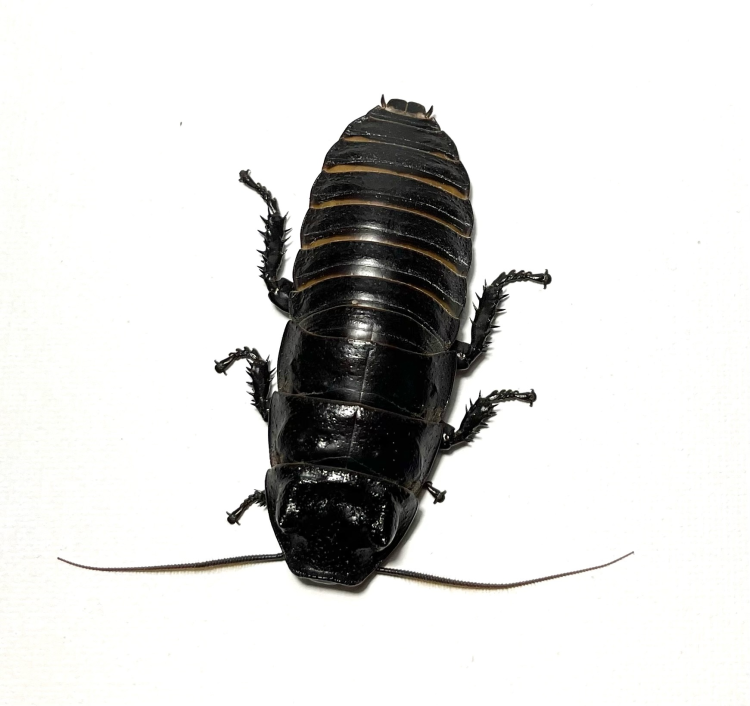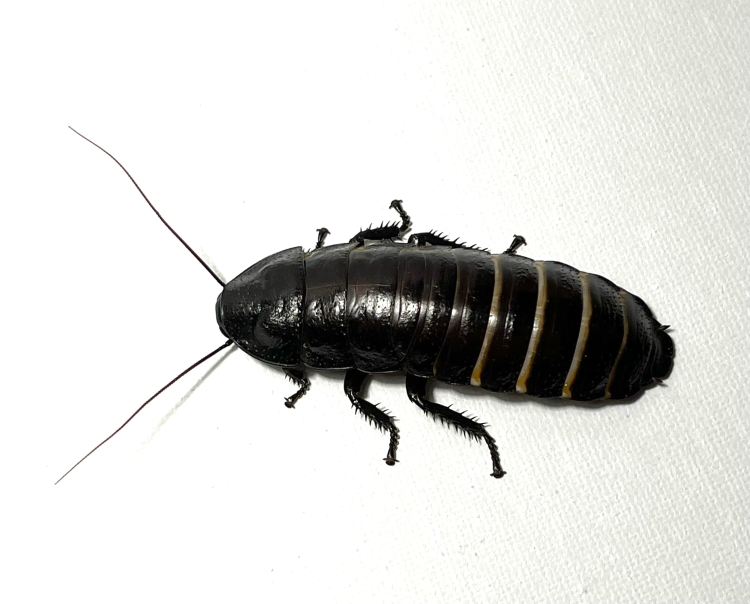Tiger Hissing Cockroaches - Gromphadorhina grandidieri
Disclaimer: I can only attest to how the species I keep respond under the conditions I keep them. Even the best care under a certain set of parameters may be met with failure under others.
For any questions or to mention anything I have wrong or have missed, email me at rockinroachesandmore@gmail.com!
Summary
Tiger hissers are an extremely easy species overall. They require little, breed readily, and, like most roaches, have little to no risk associated with handling. Properly kept hissers will have very little smell associated with them at all, and if anything, there may be a slight scent only noticable if you physically put your head in their tank. They get very large for a roach, with the largest males rivaling even the Wide-Horned hissers, and they are stout and durable. The "Black" cultivar, which I keep, is known to be even sturdier than the typical Tiger. Between their size, ease of care, and relatively quick reproductive cycle, the Tiger hisser is a handsome and forgiving species to keep, suitable for caretakers of all levels of familiarity with arthropod-keeping.
Feeding
As a cockroach, and specifically a hissing cockroach, the Tiger hisser is not picky. They prefer fruits over vegetables, but will readily accept both. Mine do very well on a steady diet of old oranges, apples forgotten at the back of the fridge, and cut-up whole carrots. I have also successfully fed them watermelon, squash, zucchini, and grapes. For some reason, strawberries are not such a bit hit, except the tops; they do like their strawberry leaves. In addition to a diet composed predominantly of fruits and vegetables, they require some form of protein, given based on the size of the colony and about twice a week. Mine are given cat food, but I imagine any sort of kibble would go over well, as well as fish food. I would not suggest any kind of raw or cooked meat, fish, or shellfish, though only because of the inevitable smell.
Environment
Tiger hissers, like many hissers, prefer warmth. The room I keep mine in is 80°F (26.7°C), with an approx. humidity of 60%. The species prefers 78°-85°F, but can withstand short experiences above that (as evidenced by an accidental night at 90°F) and will survive at temperatures lower than this, though I'm not sure where the lower limit lies. Any temperature below optimal will cause a decline in breeding, growth rate, and activity of the colony. That being said, at room temperature (approx. 74°F/23°C), breeding will continue, just slowly. Some keepers opt to provide their hissers with secondary heat sources, preferably a weak heat mat stuck to the side of the enclosure, NOT a heat lamp (too much heat, and they dislike the light) or too strong a source.
At lower humidities, a shallow water bowl may be provided with something like small rocks or marbles at the bottom to prevent drowning of nymphs, but it is much better in my experience to simply mist their cage once in a while, or, if short on time, pour some water into a corner of the substrate to soak it from the bottom, giving the roaches the opportunity to choose the humidity they remain in by wandering to or from the damp side. Otherwise, ensuring the colony always has some food with a high water content (oranges, apples, watermelon, grapes, zucchini) will be sufficient. This is not a species that wants to have a wet enclosure and, with enough good food and humidity, won't want additional water at all.
Light is a non-issue for this species. They don't require - or want - additional sources beyond a room light, though they don't seem to mind indirect sunlight from a window. Ensure the enclosure is never in direct sunlight!
Enclosure
A small starter colony of 6-12 roaches can be kept in a regular 10-gallon glass tank up until there are ~50 adults and assorted nymphs, depending entirely on the surface area of the hides they are given. They may also be kept just as easily in a Rubbermaid bin, or any largeish plastic container of a similar size, though that's not as pretty. A lid is encouraged, but not completely necessary as long as other precautions are taken (a line of petroleum jelly at least an inch thick around the perimeter of the inside lip of the tank, removal of anything in the tank that may be used by the roaches to climb out). As substrate, the options are flexible. If cost is an issue, the roaches will do well on regular outdoors soil, though I strongly suggest laying it out in a 1in thick layer and baking it at around 400°F for 20 minutes, or until totally dry, first, to prevent taking home unwanted hitchhikers or disease. I also strongly suggest you take extreme care to select soil that has not had fertilizer, insecticide, or any strong chemical applied, as the roaches, often detrivores in the wild, will nibble on most anything you put in their tank, including the substrate. Otherwise, coconut coir or (if the only option, for it's unsustainably harvested) peat moss will hold moisture and work well. This is not a burrowing species, an inch or two will be just fine. Just dampen it first, to prevent particulate matter from covering everything (and making you sneeze!) when you put it in the tank
Once you have your substrate, it's on to the décor. For this, the roaches are not picky. If it's all that's on hand, egg flats, or even plain pieces of torn brown cardboard (without tape or much printing, ideally) will do to give them somewhere to hide. The egg flats will work better, as they can be alternated to keep space between the layers. Overall, the rule of thumb is the more layers to provide surface area, the more roaches your tank can support. If you want something more aesthetically appealing/natural looking, I suggest large flat pieces of bark. It doesn't need to be cork bark, just something appropriately sized you find outside and either forget in the back of a closet for a few months to dry out, or send through the oven at the aforementioned 400°F for 20min or so. The more the better, and a 10-gallon tank can hold more than you think.
In addition to the purely utilitarian purpose of giving the roaches a hide, the contents of the tank can make it nice to look at, too. A well-set up roach tank full of handsome little guys is simply nice to look at. To this purpose, I often use plastic fake plants. I get them more than half-off at Michael's seasonally, and they really add something. Before putting them in the tank, always wash them thoroughly. I use Dawn dish soap and warm water, let them soak for a while, then give them a good scrub, let 'em dry, and throw them in the tank to arrange. Additionally, one may add leaflitter. I add some leaflitter (oak, maple, etc.) to all my roach tanks. Only a rare few species ever eat any of it, but it looks good and, most importantly, gives the nymphs somewhere to hide that retains more moisture than the rest of the tank. For this reason, I highly recommend tromping around outside and picking some up, if you can.
Other Information
- Adult size is 2.5-2.75in for females, 2.5-3in for males
- Ovoviviparous
- Wingless
- One of my large females weighed in at 12.15g! Now that's a roach.

A male Black Tiger hisser (note the horns).

A female Black Tiger hisser (note the smooth pronotum and rounder abdomen).